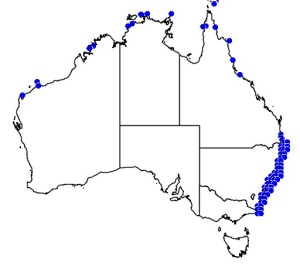Colours
Distinguishing features
The coloration is gray to brown above and white below, with a conspicuous white stripe running along the sides. The pectoral fins, second dorsal fin, and the lower lobe of the caudal fin usually have black tips. The pelvic fins and rarely the anal fin may also be black-tipped. The first dorsal fin and the upper lobe of the caudal fin typically have black edges. Some larger individuals have unmarked or nearly unmarked fins. (Wikipedia)
Size
- Up to 280 cm (Length of specimen)
Depth range
- Up to 64 m
Synonyms
Similar taxa
- Animalia: Blacktip Reef Shark (species: Carcharhinus melanopterus)
-
Animalia:
Australian Blacktip Shark (species: Carcharhinus tilstoni)
Appearance-wise this species is virtually identical to Carcharhinus tilstoni, from which it can be reliably distinguished only by its lower vertebra number and by genetic markers.
Distribution
Distribution and habitat preferences
The blacktip shark has a worldwide distribution in tropical and subtropical waters. In the Atlantic, it is found from Massachusetts to Brazil, including the Gulf of Mexico and the Caribbean Sea, and from the Mediterranean Sea, Madeira, and the Canary Islands to the Democratic Republic of the Congo. It occurs all around the periphery of the Indian Ocean, from South Africa and Madagascar to the Arabian Peninsula and the Indian subcontinent, to Southeast Asia. In the western Pacific, it is found from southern China to northern Australia, including the Philippines and Indonesia. In the eastern Pacific, it occurs from Baja California to Peru. It has also been reported at a number of Pacific islands, including New Caledonia, Tahiti, the Marquesas, Hawaii, Revillagigedo, and the Galápagos.
Favored habitats are muddy bays, island lagoons, and the drop-offs near coral reefs. They are also tolerant of low salinity and enter estuaries and mangrove swamps. Although an individual may be found some distance offshore, they do not inhabit oceanic waters. (Wikipedia)
Behaviour
Like the spinner shark, the blacktip shark is known to leap out of the water and spin three to four times about its axis before landing. Some of these jumps are the end product of feeding runs, in which the shark corkscrews vertically through schools of small fish and its momentum launches it into the air. (Wikipedia)
Diet
Fish make up some 90% of the blacktip shark's diet. A wide variety of fish have been recorded as prey for this species: sardines, herring, anchovies, ladyfish, sea catfish, cornetfish, flatfish, threadfins, mullet, mackerel, jacks, groupers, snook, porgies, mojarras, emperors, grunts, butterfish, tilapia, triggerfish, boxfish, and porcupinefish. They also feed on rays and skates, as well as smaller sharks such as smoothhounds and sharpnose sharks. Crustaceans and cephalopods are occasionally taken. (Wikipedia)


